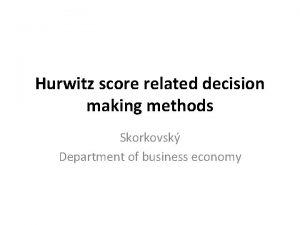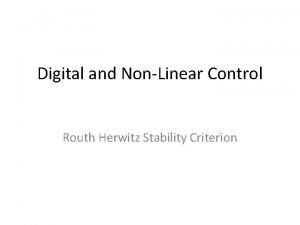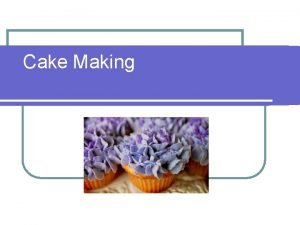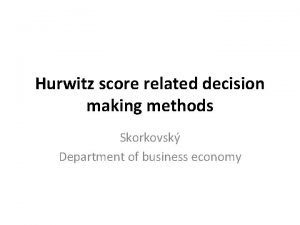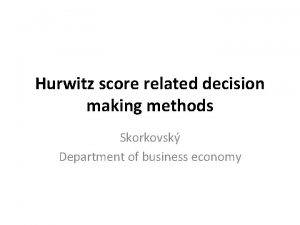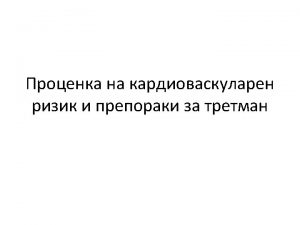Hurwitz score related decision making methods Skorkovsk Department










- Slides: 10

Hurwitz score related decision making methods Skorkovský Department of business economy

Uncertainty-Risk Although the possible returns of the investment are beyond the control of the decision maker, the decision maker might or might not be able or willing to assign probabilities to them. If no probabilities are assigned to the possible consequences, then the decision situation is called "decision under uncertainty". If probabilities are assigned then the situation is called "decision under risk". This is a basic distinction in decision theory, and different analyses are in order. 2

First approach Alternative 1 Decision Alternative 2 Alternative i A/O O 1 O 2 O 3 O 4 O 5 A 1 po 12 po 13 po 14 po 15 A 2 po 21 po 22 po 23 po 24 po 25 A 3 po 31 po 32 po 33 po 34 po 35 A 4 po 41 po 42 po 43 po 44 po 45 Decision Table (payoff table) Where : A=Alternative(action); O=Outcome (výsledek, závěr) ; po=payoff (přínos, prospěch) A=(A 1, A 2, …Ai) = inventory of viable options=vector, O=(O 1, O 2, …Ok)= outcome vector

Chosen criteria I • Maxi. Max – Maxi. Max is the rule for the optimist. A slogan for Maxi. Max might be "best of the best" - a decision maker considers the best possible outcome for each course of action, and chooses the course of action that corresponds to the best of the best possible outcomes Example of the decision table I (best of the vector {800, 400, 200, 100} is 800 !! Choices Profit Strong market Fair market Poor market invest $8000 $800 $200 -$400 invest $4000 $400 $100 -$200 invest $2000 $200 $50 -$100 invest $1000 $100 $25 -$50 Example II 4

Maxi. Max Payoff Select the alternative which results in the maximum of maximum payoffs; an optimistic criterion Payoff Table Outcomes Alternatives O 1 O 2 O 3 A B C D $1, 000 $10, 000 $5, 000 $8, 000 $1, 000 -$7, 000 $0 -$2, 000 $1, 000 $500 $800 $700 Maximum Payoff $1, 000 $10, 000 $5, 000 $8, 000 B>D>C>A Alternatives (invested amount, expectant spouse inheritance, type of the car, . . )

Chosen criteria II • Maxi. Min – The Maxi. Min decision rule is used by a pessimistic decision maker who wants to make a conservative decision. Basically, the decision rule is to consider the worst consequence of each possible course of action and chooses the one that has the least worst consequence (in our case= -50). So it is better to invest nothing !!!! Choices Profit Strong market Fair market Poor market invest $8000 $800 $200 -$400 invest $4000 $400 $100 -$200 invest $2000 $200 $50 -$100 invest $1000 $100 $25 -$50 Example II 6

Maxi. Min Payoff Select the alternative which results in the maximum of minimum payoffs; a pessimistic criterion Payoff Table Outcomes Alternatives O 1 O 2 O 3 A B C D $1, 000 $10, 000 $5, 000 $8, 000 $1, 000 -$7, 000 $0 -$2, 000 $1, 000 $500 $800 $700 A>C>D>B Minimum Payoff $1, 000 -$7, 000 $0 -$2, 000

Decision Strategy I Hurwitz criterion allows to choose strategies depending on inclination to risk A/O O 1 O 2 O 3 O 4 O 5 A 1 po 12 po 13 po 14 po 15 A 2 po 21 po 22 po 23 po 24 po 25 A 3 po 31 po 32 po 33 po 34 po 35 A 4 po 41 po 42 po 43 po 44 po 45 Example on the next slide 8

Decision Strategy II A/O O 1 O 2 O 3 a b A 1 1 5 7 7 1 A 2 3 2 6 6 2 A 3 5 4 3 5 3 Where ai = max (pi, Ok) and bi= min(pi, Ok) Where 5, 8=7*0, 8+(1 -0, 8)*1=5, 6+0, 2; 5, 2=6*0, 8+(1 -0, 8)*2, ……. 9

Thanks for Your attention 10
